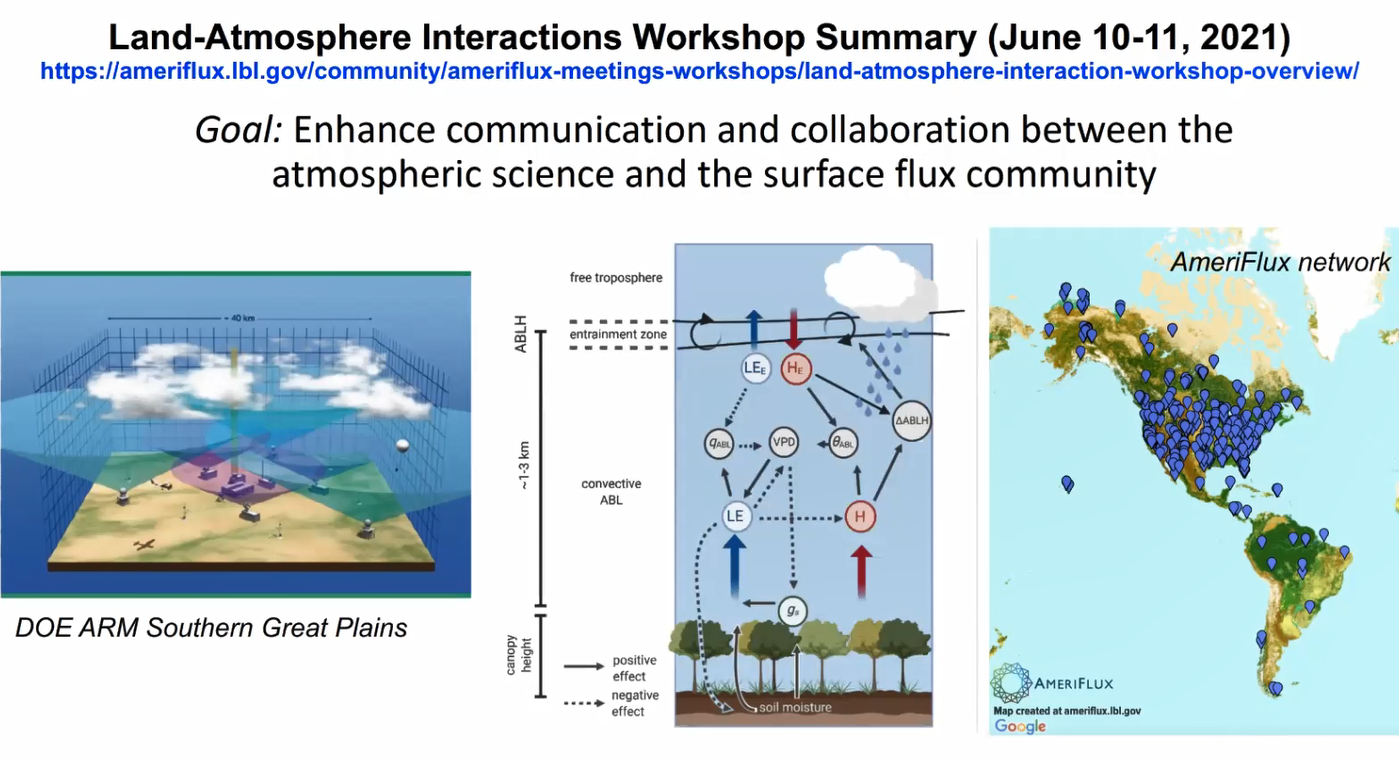Land-Atmosphere Workshop Connects Scientific Communities
Published: 20 July 2021
Organizers and presenters include representatives from ARM, ASR, AmeriFlux surface flux groups
Questions about land-atmosphere interactions are being addressed by atmospheric researchers using measurements from the Atmospheric Radiation Measurement (ARM) user facility and scientists supported by Atmospheric System Research (ASR). Ecosystem scientists are also interested in these questions, but from a different direction, looking down toward soil and vegetation instead of up into the atmosphere for answers.
But what would happen if atmospheric and ecosystem scientists worked together instead of apart?
Researchers from both communities took a step toward answering that question by gathering virtually for the Land-Atmosphere Interactions Workshop 2021 on June 10 and 11. ARM users, ARM staff, and ASR-funded scientists joined AmeriFlux surface flux community representatives as workshop organizers and presenters.
The AmeriFlux tower network, which, like ARM and ASR, is supported by the Biological and Environmental Research program within the U.S. Department of Energy (DOE), measures ecosystem carbon, water, and energy fluxes at sites across the Americas.
The workshop aimed to break down barriers in communication and enhance collaboration between the atmospheric science and surface flux communities. By doing so, the groups could jointly tackle questions about land-atmosphere interactions and the boundary layer—the lowest part of the atmosphere.

About 400 people registered to attend, with 100 to 200 participants signed in at any given time during the workshop. Attendees logged on from the United States, Mexico, South America, and Europe.
Invited speakers included ARM Engineering and Process Manager Jennifer Comstock, who gave an ARM overview; and Chongai Kuang, Pierre Gentine, and Allison Steiner, a trio from the site science team helping with the move of the third ARM Mobile Facility from Alaska to the Southeastern United States. ARM and ASR are supporting the site science team.
Comstock’s presentation focused on how ARM supports studies of land-atmosphere interactions and boundary-layer processes through its observations and capabilities. Kuang, the site science team lead, presented on the upcoming mobile facility move and “critical ‘surface-up’ observations to characterize land-atmosphere interactions on boundary-layer processes.” Gentine and Steiner gave big-picture talks on feedbacks between the land and atmosphere.
Giving and Receiving Input
“We really saw that there’s a need for more coordination, but there’s also a desire for more collaboration.”
Manuel Helbig, who helped organize the Land-Atmosphere Interactions Workshop 2021
In addition to invited talks on instrumentation and remote sensing, modeling, water fluxes, clouds, aerosols, and the broader picture of land-atmosphere interactions, the workshop included breakout sessions and posters.
Participants pondered research questions to address by combining existing surface flux and atmospheric measurements, and they discussed future measurement priorities. Attendees also considered how increased collaboration between ecologists, biogeoscientists, and atmospheric scientists could improve predictive understanding of biosphere-atmosphere interactions and land-atmosphere coupling.
About two weeks after the workshop, the 2021 Joint ARM User Facility/ASR Principal Investigators Meeting featured a breakout session on interactions among the land surface, convective boundary layer, aerosols, and clouds. Larry Berg from Pacific Northwest National Laboratory in Washington state and Yunyan Zhang from Lawrence Livermore National Laboratory in California led the session.
At one point, Berg and Zhang gave the floor to Manuel Helbig to summarize the workshop as a member of its organizing committee. Helbig is an assistant professor in the Department of Physics and Atmospheric Science at Dalhousie University in Halifax, Nova Scotia.
Participating in his first ARM/ASR joint meeting, Helbig shared key findings from the exit survey given to workshop attendees. The feedback indicated that the workshop helped researchers better understand the work coming from the other community.
“We really saw that there’s a need for more coordination, but there’s also a desire for more collaboration,” said Helbig.
The virtual format also allowed for attendance by those who otherwise might have missed out on an in-person workshop, including some early career scientists.
View the list of talks and speakers on the workshop website, and watch this YouTube playlist of presentations from the workshop.
To the Future
Next, Helbig would like to see atmospheric and surface flux scientists write grant proposals together and leverage existing flux tower sites for collaborative research.
“The biggest challenge will be how can we continue the communication and push it forward because I think the workshop was great, but it was only a first step,” said Helbig.
The December 2021 American Geophysical Union Fall Meeting will include two sessions focused on boundary-layer research. One will be more geared toward integrating boundary-layer and ecosystem observations, and the other will be a broader session on land-atmosphere interactions. The abstract submission deadline for these sessions is August 4.
Other follow-up efforts being considered include a special journal issue, a meeting report, and a Land-Atmosphere Interactions Workshop 2022.
To be included in future communications on this topic, please email landatmosphere2021@gmail.com.
Keep up with the Atmospheric Observer
Updates on ARM news, events, and opportunities delivered to your inbox
ARM User Profile
ARM welcomes users from all institutions and nations. A free ARM user account is needed to access ARM data.


















